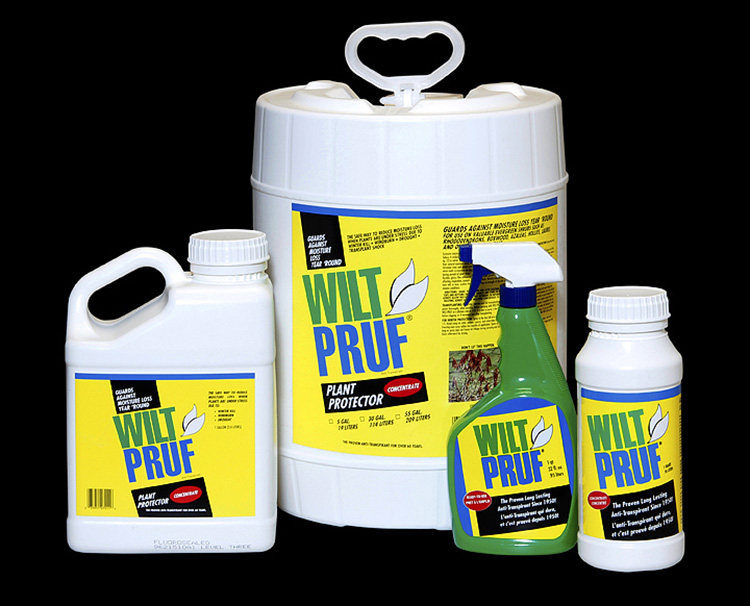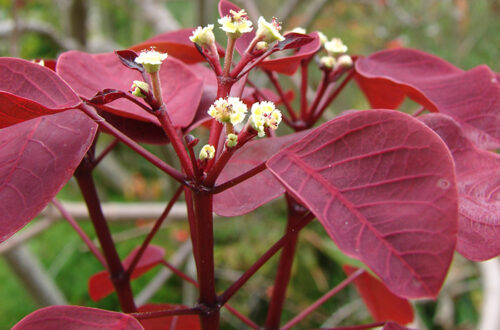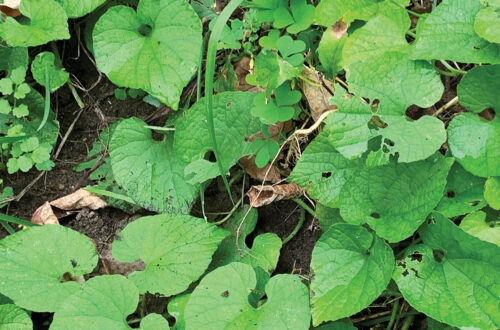By Will Rowlands
SEPT-OCT 2014 – The way Brad Nichols tells it, there was an building boom after World War II and landscapers found themselves working straight through the hot summers.
If necessary, of course, one can transplant shrubs and trees in July and August, but it can get hot so you need to consider a plant’s water requirements.
In response, Luther von Gartner invented Wilt-Pruf, the world’s first anti-transpirant (some call it an anti-desiccant). The original version was rather goopy and sticky, according to Nichols, now president of Wilt-Pruf Products Inc.
Nichols says the product really took off about 60 years ago when Joe Hartman purchased the company. The product’s characteristics improved when it was reformulated with pine resin by Miller Chemical. Nichols bought the company, now headquartered in Essex, about 40 years ago.
How Does It Work?
According to the manufacturer, “Wilt-Pruf acts as a protective coating, holding in moisture on plant foliage and stems, substantially reducing water loss during periods of plant stress.”
It protects broadleaf evergreens such as rhododendrons, azaleas, hollies, boxwood, laurel along with many other ornamentals.
The coating is clear and flexible, does not inhibit growth and has no material effect on osmosis, respiration or photosynthesis.
You’ll often see Wilt-Pruf on the shelves of garden centers in the fall but it can be used almost any time of year, whenever excess transpiration is a concern. Potential uses include protection from transplant shock, shipping, freezing roots, soaring temperatures, desiccating winds and drought conditions.
Details
While the product can be used in a wide variety of situations, there are some guidelines. Nichols stresses that you need to apply it outside during daylight hours, as UV rays are necessary for the drying process. He suggests applying around 10 o’clock in the morning to give it a few hours to dry.
Dilution Rates
• Winter Kill – 1 to 5
• Drought & Windburn – 1 to 10
• Transplanting – 1 to 10
• Shipping Protection – 1 to 10
• Tuber & Bulb Storage – 1 to 10
• Roses– 1 to 10
• Christmas Trees – 1 to 10
• Decorative Greenery – 1 to 5
Wilt-Pruf is mixed to different dilution rates depending on the use so you need to follow the directions. Be sure to shake well – thorough mixing is important. A paint stirrer attached to a drill works well. Always add the Wilt-Pruf to water. Never add water to Wilt-Pruf, as the resulting consistency can clog your sprayer.
Timing Is Everything
You also have to watch out for freezing. You don’t want the product to freeze when it’s applied, or during the subsequent drying period. Since temperature may not always be an accurate yardstick, Nichols suggests splashing some water on a branch as a test.
Also, don’t apply Wilt-Pruf to arborvitae, cypress, juniper or cedar until the plants have hardened off for the winter and moisture has retreated down into the roots or cell bursting may occur. This can happen naturally, but Wilt-Pruf would likely exaggerate the effect.
Keep in my mind that Wilt-Pruf’s active life is one season, or approximately two months during the warm summer months and around four months during winter.
Wilt-Pruf is used primarily on evergreens but it can be used on deciduous plants, such as hydrangeas or roses, if the timing is right (after the plant has gone dormant). It is not recommended for use on plants with hairy leaves.
There are also some finer points. You can apply Wilt-Pruf to curled rhododendron leaves but you’ll get better coverage and results if the leaves aren’t curled. If you use it on blue spruce the needles will turn green temporarily. Visit the company website for extensive information and a video.
What Exactly Is It?
According to the company, Wilt-Pruf is organic, non-hazardous, non-toxic and biodegradable. It’s the purified organic resin of conifer trees to which emulsifiers and stabilizers are added. Even so, it’s always wise to err on the side of caution as inhalation or contact may cause irritation to eyes, nose, throat and skin.
The product has a very long shelf life. Nichols says he has 20-year-old product that’s still good, but make sure you shake old product well before use.
Wilt-Pruf does not clog sprayers, nozzles or lines (remember to add it to water, not the other way around) and can be cleaned up with water unless it’s allowed to dry. It may not work well, however, with certain sprayers, such as the ones used for window cleaners.
If you overspray and allow the product to dry it can be difficult to remove, so it’s often best to just let it wear off.
For Storage
Wilt-Pruf can be used when you store tubers, bulbs and bare-root stock over the winter when moisture control is critical. Rodale’s Book of Practical Formulas, for example, includes Wilt-Pruf in a mixture for storing dahlia tubers.
Non-Standard Uses
Gardeners, being a creative lot, have used Wilt-Pruf in ways that are not promoted or even suggested by the company. You’re on your own if you use Wilt-Pruf as an anti-fungal, deer repellent or “sticker extender.”
Other Uses
• On cut or live Christmas trees, wreaths and greens
• On indoor plants whenyou’re away
• Wilt-Pruf will also protect plants from salt. This is relevant if your property is subjected to salt spray or you have plants that are impacted by the salting of roads during the winter.
For more information, go to wiltpruf.com or call 1-800-324-0705. Check out the store locator on the website or ask at your local garden center.
To purchase Wilt-Pruf online, go to wilt-pruf.com





